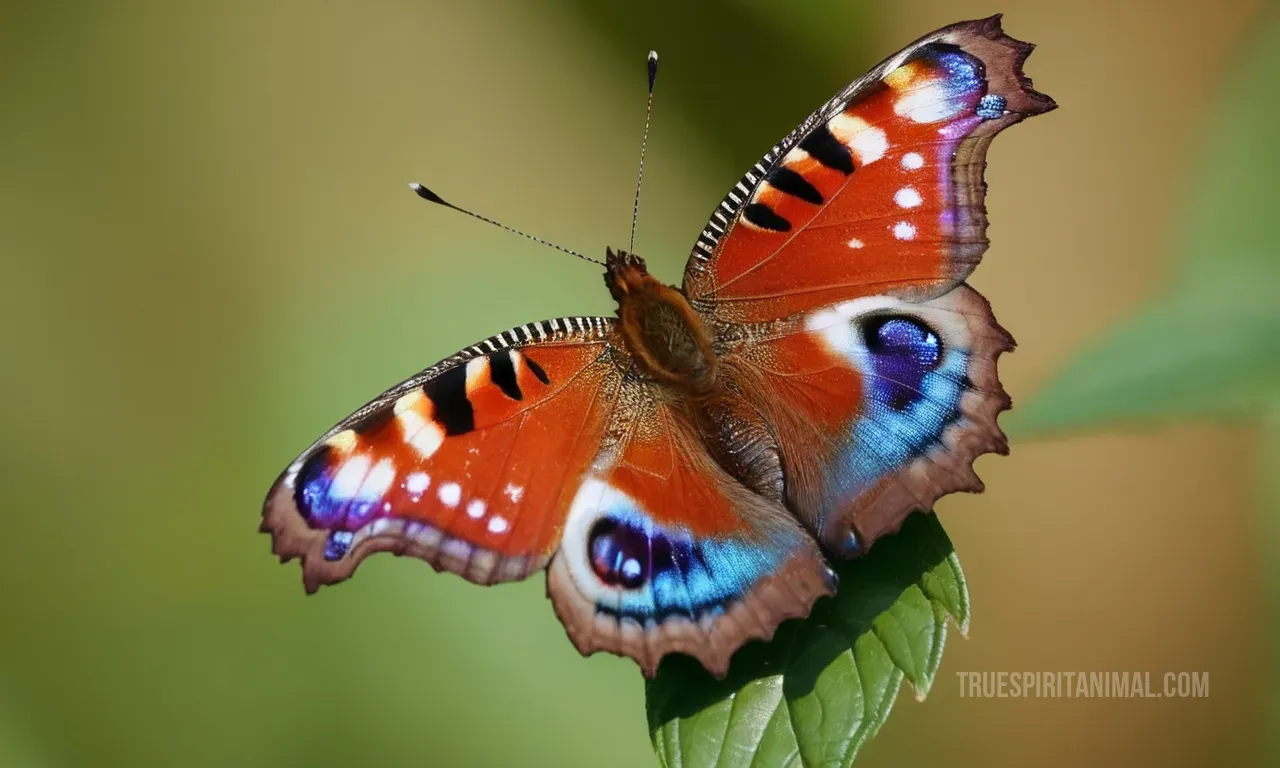Peacock Butterfly Symbolism and Meaning

With its vibrant colors and captivating patterns, the peacock butterfly has long been associated with spiritual symbolism across cultures. This graceful insect represents themes of transformation, beauty, hope, and the interconnectedness of life.
The Physical Characteristics and Lifecycle
The peacock butterfly, known by the scientific name Aglais io, is a familiar sight in woodlands and gardens across Europe and temperate Asia. Adults have wingspans reaching 2 to 3 inches, colored in striking shades of reddish-orange, blue, yellow and black. Their most distinctive feature is the four large, eyespot designs on the wings, featuring concentric bands of color reminiscent of a peacock’s feathers.
These butterflies have a fascinating lifecycle that lends itself well to symbolic meaning. The caterpillars hatch in early summer, feed on stinging nettles, and spin an intricate web to pupate in. They emerge from their chrysalises as butterflies by late summer. The adults live for around 12 months, feeding on nectar, hibernating over winter, and re-emerging in spring to start the cycle again.
Symbolic Themes and Meaning

Transformation and Spiritual Growth
Like all butterflies, the peacock butterfly is strongly linked to themes of transformation and spiritual evolution. Its metamorphosis from caterpillar to winged adult reminds us of the capacity for profound change in our own lives. It carries a message to embrace personal growth.
The intricate patterns decorating its wings also represent the interconnectedness of life during this process of change. The peacock butterfly inspires us to see each experience as part of an unfolding journey.
“The peacock butterfly emerged transformed, a creature of delicate beauty belying the strife of its beginnings.”
Hope and Resilience
In some cultures, the peacock butterfly also symbolizes hope and resilience. Its dramatic metamorphosis reminds us that no matter the struggles we face, we have the strength within us to transform. Like the butterfly emerging vibrantly from its dark cocoon, we too have the capacity to weather storms.
The peacock butterfly appears early in spring, bringing its hopeful symbolism to bear just when nature needs it most. Seeing it dance through the air reassures us that better times always follow the cold winds of winter.
Joy and Celebration
Many societies associate the peacock butterfly with joy, festivity, and celebration. Its brightly colored wings and energetic, floating flight seem to embody a playful spirit.
In Europe, early arrivals of the peacock butterfly in spring are welcomed as a positive omen marking the end of winter. Their presence graces special occasions like weddings with a sense of cheer and optimism for the couple’s future happiness.
Beauty, Grace and Charm
Given its striking, eye-catching patterns and wings, the peacock butterfly is an archetype of natural beauty in many cultures. It represents elegance, grace, and charm.
The intricate eyespots may also symbolize the notion of seeing true beauty in the world. As we open our eyes to appreciate the wonder around us, embodied by this butterfly’s charm, our spirits are lifted.
Cultural and Spiritual Significance
The peacock butterfly holds meaning across belief systems:
- Christianity: Seen as a symbol of resurrection and eternal life due to its dramatic metamorphosis. The patterns resemble divine eyes watching over us.
- Hinduism and Buddhism: Represents spiritual awakening, the soul’s journey, and non-attachment. Reminds us that joy comes from within, not external beauty.
- Native American: Symbolizes intuition and vision to see beyond the physical world. The eyespots embody the capacity for inner sight.
- Celtic: Associated with celebration, luck, and happiness – a magical creature bringing joy and blessing.
- Chinese Culture: The gift of a peacock butterfly ornament expresses wishes for a happy marriage full of color and harmony.
Encountering the Peacock Butterfly in Nature
When we notice a peacock butterfly dancing through the air, it’s important to pause and appreciate its significance. Seeing one is an opportunity to reflect on themes of growth, resilience, and embracing life’s beauty.
Pay attention to what aspects of the peacock butterfly’s symbolism resonate most in the moment. Are you being called to transform something in your life? Does witnessing its charm lift your spirits or make you see the world differently? Contemplate how its messages may apply to you.
Simply taking a moment to admire the peacock butterfly’s grace can reconnect us to a sense of joy and magic in the present. Noticing these meaningful creatures is one way to practice mindfulness, gratitude, and presence.
Key Takeaways
- The peacock butterfly represents powerful symbolic themes like transformation, hope, celebration, and embracing natural beauty.
- Its dramatic metamorphosis from caterpillar to winged insect reminds us of the potential for profound change in our spiritual evolution.
- This butterfly brings messages of resilience – assurance that no matter our struggles, we can emerge transformed.
- Many cultures associate the peacock butterfly with joy, luck, and festivity due to its colorful, lively nature.
- Taking notice of this graceful creature in nature is an opportunity for spiritual reflection and mindfulness.
With its depth of symbolism and significance across cultures, the vibrant peacock butterfly delivers an uplifting, inspiring message when it graces us with its presence. Keep your eyes open for a sighting this spring!




